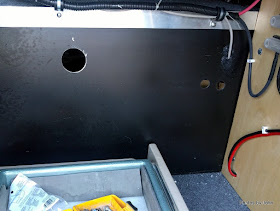Our original plan had been to replace the original 12 volt batteries with a pair of Interstate GC2 6 volt golf cart batteries that were easily available from our local Costco, but BJ and I were wandering the Mesa Market Place one day and ran across a couple outfits with excellent prices on Trojan batteries. I turned Jeff loose to do some research.
He talked with both vendors and ended up getting four US Battery 232 amp hour batteries for $110 each (plus tax.) These were fresh batteries - the construction date stamped on their posts was October 2017. With that sort of pricing, it was an easy decision to upgrade from the 205 amp/hr batteries at Costco.
The original battery tie-down bolts were 9 1/2 inch long carriage bolts. With the new, taller batteries, we needed 11 inch bolts, but my favorite hardware store only stocked them to 10 inch long, so we used Nyloc self locking nuts and fender washer on 12" long piece of all thread. On the top, we were able to reuse the tie plates and nuts. With two batteries in place we were already up about 50% on available amp hours.
The base for the battery box drawer was attached with four bolts through the bottom of the storage bay, retained by fender washers and nyloc nuts on the bottom.
Battery boxes for a pair of GC2 sized batteries are not terribly common. We got this one from All Battery Sales & Service in Everett, Washington because I'd been so happy with the one I've used on our Scamp for the past six years.
I wanted to vent the box overboard so I added a PVC conduit body to the cover, attaching the body with two screws and sealing it with trusty 3M5200.
I'd hoped to be able to vent directly out, but the battery box height was such that the vent would hit the aluminum angle that forms part of the storage bay. I drilled a 2" hole through the back of the bay as well as 7/8" holes for the battery cables.
A couple of elbows and some 1 1/2" PVC pipe created the offset solution for the vent.
The vent pipe slides over the sleeve on the conduit body. The other hole in the conduit body is unnecessary and closed with a plug.
The battery box is retained in the drawer in case the driver wants to try some aerobatics. I elected to us a 4' loop strap from NRS.
The NRS loop strap is built for use on white water rafts, but the cam buckle works excellent and I've had a long history of success with these, so it became my logical choice for a simple tie-down system.
We used 1/0 battery cables from Windy Nation on Amazon for the 18" ones that we needed with the batteries in the original location. Unfortunately, they apparently don't do custom lengths, nor 6' long lengths. I didn't want to deal with the extra length or the wait, so we had cables custom built by a local auto stereo shop for the connections to the batteries in the drawer. They are retained by Adel clamps screwed to some aluminum angle that is riveted in place.
For this system, we're now very battery heavy. The batteries could easily support two or three more panels, but it gives Jeff the capacity to enjoy a week of rainy, overcast fishing without needing to fire up the noise maker.











Quite an ambitious project, that shows off your skills. Well done!
ReplyDeleteI'm pleased with how it turned out, Jeff is very pleased with his battery capacity now.
DeleteDid you consider lithium-ion batteries? Do you have any thoughts on Blue Sky Energy charge controllers? Also, what are you using for wire bushings when passing through the storage bay? I'm planning on doing something like this, so thanks for all the information you post, it is very helpful.
ReplyDeleteFor this project we didn't consider lithium-ion. If he were setting it up for full-timing, it would have more panels and perhaps Li-ion batteries.
Delete